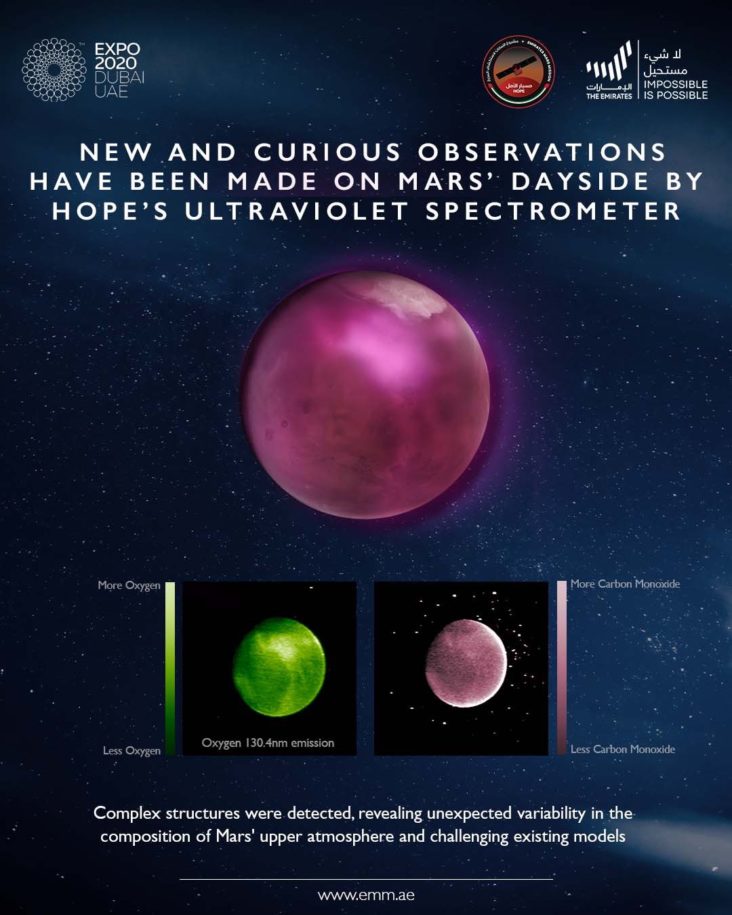Emirates Mars Mission Unveils New Insights Into Turbulent Martian Atmosphere

The Emirates Mars Mission, the first interplanetary exploration undertaken by an Arab nation, Saturday released unique new images of Mars that challenge existing conception of how the planet’s atmospheric gases behave and interact. Taken by the Mars Hope probe’s EMUS instrument, the observations show dramatic variations in the concentrations of both atomic oxygen and carbon monoxide in the dayside atmosphere of Mars.
“These observations contain features that were completely unexpected and we believe will have far-reaching consequences for our existing models of the Martian atmosphere and our understanding of its behaviour. We simply hadn’t anticipated structures of this magnitude and complexity,” said Emirates Mars Mission Science Lead, Hessa Al Matroushi.
The new findings are included in the first data release from the Mission, which was opened up to public access on 1st October 2021, and follow on from the Mission’s revolutionary observations of the Martian discrete aurora. Both new observations come early in the Mission’s lifetime and have significant implications for understanding of the Martian atmosphere and its interaction with solar radiation.
The observations confound scientist’s preconceptions of the distribution of ultraviolet light emitted from the upper atmosphere of Mars, showing vast structures at a range of wavelengths suggesting a higher than expected variation in the density of atomic oxygen and pointing to unusual levels of atmospheric turbulence. Taken at a time when Mars was near the aphelion of its orbit (furthest from the Sun) and when solar activity was low, the images are at their most striking and remarkable in emissions from oxygen at the 130.4 nm wavelength.
“It was so unexpected that we initially thought the structures might be artefacts in the image, caused by contaminating light from longer wavelengths that the instrument is designed to reject,” said EMM Deputy Science Lead Justin Deighan. “We had expected to observe a relatively uniform emission from oxygen at 130.4 nm across the planet and yet here we are, faced with unpredicted variations of 50% or more in the brightness. The science team is currently refining their models to come up with a robust interpretation of these findings. It’s very exciting to be challenged this way; this is exactly the type of science the mission was designed to pursue.”
One of three instruments on board the Mars Hope Probe, EMUS’ principal science goal is the measurement of oxygen and carbon monoxide in Mars’ upper atmosphere and the variability of hydrogen and oxygen in the exosphere. EMUS (Emirates Mars Ultraviolet Spectrometer) is the most sensitive ultraviolet instrument yet to orbit Mars.
“We have been refining our processing pipeline, readying for our first science data release to the global science community, which took place as scheduled on the first of October,” commented Al Matroushi. “These observations, and our previously announced observations of Mars’ discrete aurora, will form part of that initial data release, which includes observations made by Hope between 9 February to 22 May 2021. From now onwards, we will be releasing new data sets every three months without embargo and free for use to the community.”
The Emirates Mars Mission is studying the relationship between the upper layer and lower regions of the Martian atmosphere, giving the international science community full access to a holistic view of the Martian atmosphere at different times of the day, through different seasons.
The Mission’s Hope Probe is following its planned 20,000 – 43,000 km elliptical science orbit, with an inclination to Mars of 25 degrees, giving it a unique ability to complete one orbit of the planet every 55 hours and capture a full planetary data sample every nine days throughout its one Martian year (two Earth year) mission to map Mar’s atmospheric dynamics.
EMM and the Hope probe are the culmination of a knowledge transfer and development effort started in 2006, which has seen Emirati engineers working with partners around the world to develop the UAE’s spacecraft design, engineering and manufacturing capabilities. Hope is a fully autonomous spacecraft, carrying three instruments to measure Mars’ atmosphere. Weighing some 1,350 kg, and approximately the size of a small SUV, the spacecraft was designed and developed by MBRSC engineers working with academic partners, including LASP at the University of Colorado, Boulder; Arizona State University and the University of California, Berkeley.
The Hope Probe’s historic journey to the Red Planet coincides with a year of celebrations to mark the UAE’s Golden Jubilee.


